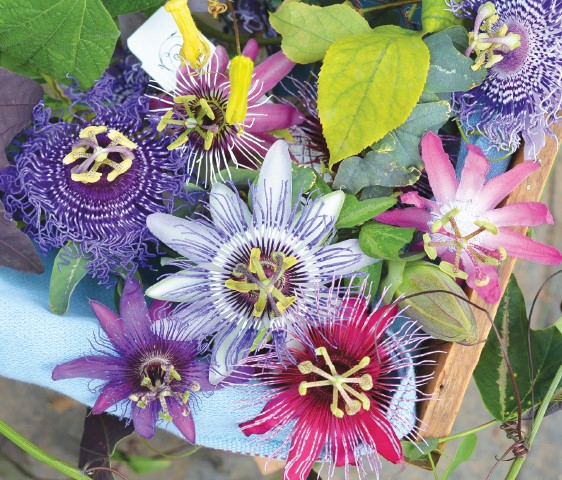Folklore supports the notion that certain plants attract fairies, whose sole purpose and motivation is the care of the garden. Though they may be perceived as mischievous, engaging in occasional pranks and games, fairies are born with a dedication to their chosen plant, flower or tree. It is said, when a seed sprouts, a Flower Fairy is born, and each fairy lives in its plant caring for and nurturing it.
Also according to ancient lore, every flower fairy is charged with keeping its plant strong and healthy, assuring it has sufficient sunshine, nutrients and moisture to thrive; including sweeping away dead leaves and spent blooms while polishing the foliage and stems daily. These tiny nature sprites bring their own distinctive personality, which conveys the aesthetic mood and character of each plant.
The term “trooping fairies” refers to groups that travel together forming settlements, associations or hamlets for their kin as opposed to solitary fairies that prefer a singular life. Imagine a community of these tiny creatures coming upon an expanse of passionflowers with astonishingly fragrant blooms resembling “miniature ballerinas, dressed in frilly tutus and crowns of antenna on their tiny heads.” This must be utopia, paradise, heaven, a Shangri-La waiting to be colonized, an enchanted and magical land where fairies may dwell.
Passiflora (passion flowers or passion vine) is a genus of over five hundred species of flowering plants—mostly tendril-bearing vines although there are shrubs and trees as well. Passion flowers produce spectacular and dramatic blooms. In sizes from one-half inch to six inches with vibrant colors and a heady fragrance, they flourish naturally from South America through Mexico.
Most passionflowers are perennial in zones 6-10 and will thrive if planted in a bright spot with at least four hours of sun each day, however they are also delicate so a partially protected location out of the wind is preferred. A well-draining soil rich in organic matter is favored with the use of an organic mulch for the roots. Keep the plants well-watered in summer months to promote robust and vigorous flower and fruit production.
Several passionflower species are grown for their fruit as well as their exotic beauty. Most species have round or elongated fruit from 2-8 inches long and 2 inches across depending on the cultivar. P.pinnatistipula has a round fruit while the banana passion flower and P.mixta have elongated tubular fruit and sport bright red and rose colored petals. Maracuja is cultivated exclusively for the fruit juice and the pink or yellow fruit.
Sweet granadilla is another fruit bearer that is widely cultivated; Passiflora edulis generates a guava-like fruit used in commercial passion fruit production. Maypop is a common species in the United States that is grown for its yellow fruit about the size of a chicken egg and sweet in flavor. Maypop has a traditional and long history of use in Native American culture, the leaves as a sedating tea and in dried powder form as a dietary supplement.
There is insufficient clinical evidence that passionflower has any positive medicinal power, but they are approved as a food ingredient. Some possible side effects may include drowsiness, nausea, dizziness, heart rhythms or asthma.
The Drama of the Passionflower
Vibrant, flamboyant hues and heady fragrances make these passionflowers a welcome addition to any garden.
- Aphrodite Purple Nightie- Pink and purple, full sun
- Blue Bouquet Caerulea- Blue, purple, and ivory, low-maintenance, fast growing, scented blooms, fruit producer
- Blue Velvet- Award-winning flowers with halos of blue, white and purple filaments, will produce edible egg-sized orange fruit, evergreen from the roots
- Blue Crown- A striking crown of deep sapphire blue fila
 ments against white petals, attracts bees and butterflies, fragrant, fast growing, perennial in the ground, blooms from July until hard frost, easily container-grown as an annual or if moved indoors in winter months
ments against white petals, attracts bees and butterflies, fragrant, fast growing, perennial in the ground, blooms from July until hard frost, easily container-grown as an annual or if moved indoors in winter months
- Victoria- Deep pink blooms with dark green foliage and stamens, edible carrot-colored fruit, container grown if moved inside in winter months
- Clear Sky- Blue and white blooms, fragrant, cold hardy in sunny locations, easily container-grown
- Ruby Glow- Maroon-cranberry nutmeg scented blooms, lavender and deep purple filaments and contrasting white band, lush leathery green leaves, yellow fruit, protect base with mulch for return in spring, hearty vine
- Pure Vida Red- Star-shaped red flowers with purple filaments and white throat, may grow to 8 feet, prefers some shade in hot climates, can be container grown
- Scarlet Flame- Scented scarlet blooms with bronze leaves, fast grower, full sun, perennial evergreen, easily grown in patio containers
- Constance Elliot- Evergreen climber, star-shaped pure white blooms on purple branches, fragrant
- Maypop- Common species called the purple passionflower, very hardy and can withstand temperatures to -20 degrees, fast-growing, easy maintenance and nearly pest-free
Passionflower Tips
- Cultivate along walls, fences, and trellises; may grow up to twenty feet in a year.
- Can be grown outdoors in containers and taken inside during winter months.
- Prune the vines in spring to control growth and promote lush foliage and increased bloom production.
- If the blooms have been fertilized by bees, wasps, or hummingbirds, a fruit will develop at the site.
- Treat spider mites, scale, and other insects with applications of insecticide.
- Fertilize with balanced fertilizer monthly.
- Avoid fungal infections by watering beneath the plant rather than from above or by spraying with a fungicide in the spring.
- Protect from snails with applications of snail bait.